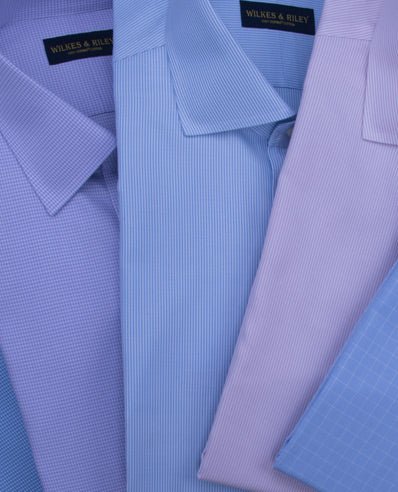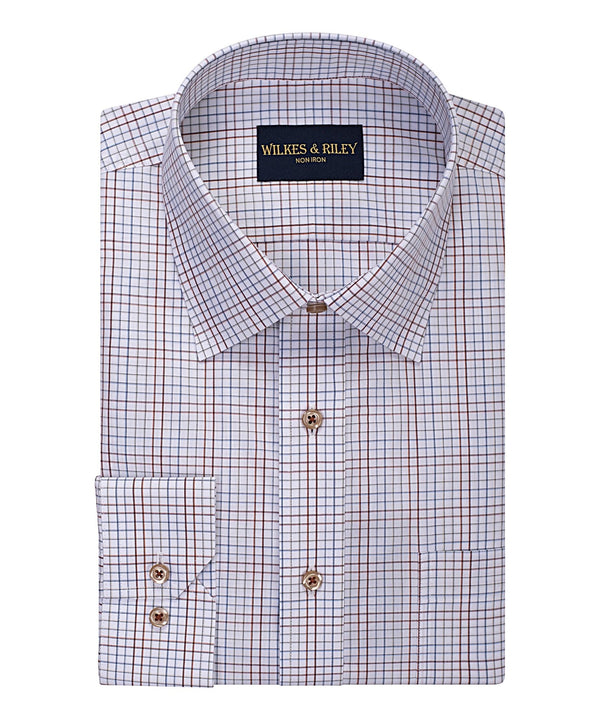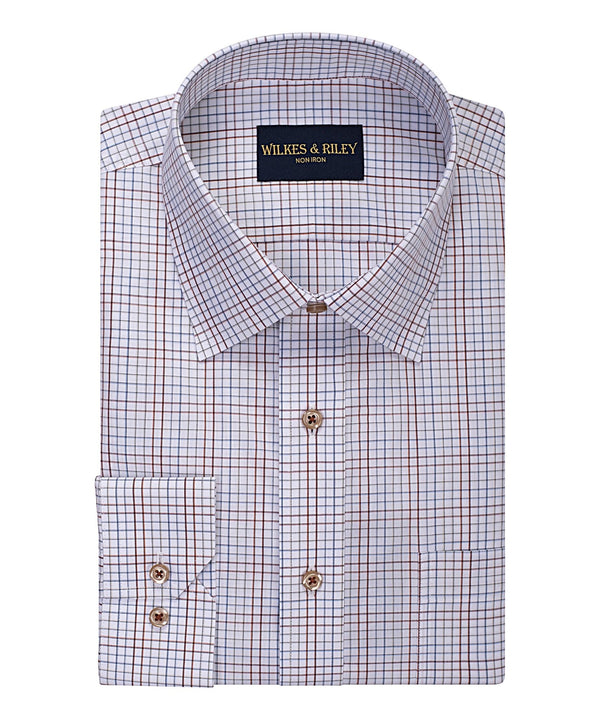Having been responsible for product development, sourcing, quality and purchasing of 33 million dress shirts in my career, I guess you can call me an expert when it comes to shirts. I've visited factories in every corner of the world and walked down countless sewing lines. When I developed Wilkes & Riley shirts I focused on the following seven components: fit, workmanship, fabric, performance, trim, consistency and country of origin. Each component plays a significant role in the quality of a shirt.
Fit
A great fitting shirt begins with a great pattern and creating patterns takes years of experience. Honestly, if the shirt does not fit a person well then the rest of this article has little value. All retailers promote their fantastic fitting products but it only matters if it fits you. If you are buying in a store, then take the time and try it on. If buying online, make sure you buy from a company who offers free returns in case it doesn't fit correctly. Why should you be out any money if it doesn’t fit?
Workmanship
How well the shirt is constructed is a critical to the overall shirt. Is the fabric pattern matched? The following areas of your patterned shirt should be matched:
- Shoulder to sleeve
- Front shirt panels to front placket
- Pocket (if any) to front shirt panel
- Split yoke (if any)
- Sleeve placket to sleeve
These aesthetics are often overlooked but are signs of a well made garment. Pattern matching requires a level of skill that many manufacturers cannot achieve. Additionally, it is more costly as it requires the factory to operate at a slower speed and also consumes more fabric.
Stitching - Review the stitching on the shirt. Is the stitching consistent? Stitching inconsistencies throughout a garment is a sign of poor quality. Are the stitches per inch (SPI) adequate? Typically you will find between 14-22 SPI on a dress shirt. A shirt with a higher SPI will generally be a better made garment but there are exceptions to every rule but that’s a whole other article.
Single needle tailoring - Is the shirt constructed with single needle tailoring? The benefits are not just appearance in which the shirts looks cleaner and lays flatter, but the seams are also stronger. The reason, again, to not do it is cost. More sewing operations are required and therefore more expensive to produce.
Split Yoke - Is there a split yoke at the center of your shoulders? The yoke joins together the front and back panels of the shirt; this provides a little give when you are moving around and is another hallmark of a well made shirt.
Collar - The collar of the shirt should be symmetrical when comparing one side to the other. Does your shirt have removable collar stays? Always remove them when laundering your shirt, otherwise the hot pressing can cause the outline of the collar stays to appear on the outside of your shirt.
Shirt tails - Is the length of the dress shirt long enough to remain tucked in? Since the fabric cost is typically 60%-70% of the cost value of the shirt, many retailers will cheat by reducing the length in order to save money. In the case of some sport shirts, they may be designed to always be worn un-tucked. Be sure to try on all shirts to make certain you are satisfied with the length.
Fabric
Since the fabric is what touches the body, most people should pay attention to the quality of the fabric but do you really know if it’s good? Will it hold up after multiple washings? You will see many retailers promoting the quality of their shirting fabric from 80 2-ply and up to 200 2-ply and even higher. As good at that sounds, I am more interested in knowing who the weaver of the fabric is as this will tell me more about the fabric quality. For example, a shirt woven at Thomas Mason, Albini, Canclini and Monti has equal appeal to me as does the yarn count. Why? Because I have purchased many shirts that, after two washes, the finishing washed away leaving the shirt limp and lifeless. Also, the higher the yarn count, the more susceptible to wrinkling. High-end mills use extra long-staple Supmia or Egyptian cotton which are superior due to their fiber length and provides strength and durability after multiple washes. Unfortunately not all yarn used is the same so buyer beware. Ask questions so you know what you're buying.
Performance
When it comes to wrinkle free or non-iron shirts, it seems like every retailer now-a-days offers their version of a wrinkle free shirt. To avoid being too technical, there are basically two types: "pre-cured" and "post-cured garment dipping." Pre-cured fabric means that the fabric is treated in the weaving mill where a resin is applied to the fabric to keep it wrinkle free. While this process is improving, it is viewed as lower quality because the wrinkle free properties wash out more quickly, depending on the mill. A dead giveaway that you have a pre-cured shirt is that you will not see a crease on the sleeve. Post-cured garment dipping is the pinnacle of wrinkle free or non-iron shirts. You will find these shirts at Brooks Brothers and Wilkes & Riley. A garment dipped shirt means that after the shirt is constructed, it undergoes a special treatment that is applied to the garment and pressed perfectly into place (one small mistake and the shirt has to be thrown out) and then baked in an oven at a high temperature, washed again and pressed. The end result of these additional steps is that the shirt has the highest durable press rating (DP), which simply means it better prevents wrinkling more than the pre-cured process. You'll look as good when you take the shirt off at night as you did when you put it on in the morning. There are only three or four manufacturers worldwide that can produce this level of quality. It requires a very high degree of technical expertise which most manufacturers do not have. In 2006, the Wall Street Journal compared wrinkle free shirts from various retailers and voted the shirt that I developed "best overall." Today, nearly ten years later, Wilkes & Riley introduces a far superior non-iron shirt. With the highest wrinkle free performance combined with exceptional softness of Supima cotton we are ready to take on all challengers!
Trim
Most Dress shirts today are made with fused interlining in the collar and cuff. Take time to feel the collar and be sure that there is adequate body. You don't want a vice around your neck but you also don't want it too soft. You want the collar to have the right amount of body so the collar sits up nicely. If a collar is too soft it will lay flat like a sport shirt.
Buttons - Like most men, when the button breaks we feel like we have to throw the shirt out. It's a catastrophe. Polyester buttons, which are on most shirts, are generally inexpensive. There is no such thing as an unbreakable polyester button. Why do they break? Inferior buttons use cheap quality resins that harden more quickly and warp causing them to become brittle and crack with age. The durability of a polyester button can be increased by modifying the shape and using higher quality resins which prevent the button from warping even after exposure to hot temperatures . Most shirts are sent to the dry cleaner for washing and pressing and are exposed to very hot temperatures. This can be deadly for cheap buttons. At Wilkes & Riley, our buttons are boil tested to simulate the aging process. A batch of buttons are placed into boiling water, removed and left to cool overnight. The next day, each button is individually tested. A weight is dropped onto each button to test for cracking. If any button cracks, the whole lot is rejected.
- Mother of Pearl buttons - Expensive, beautiful and typically found on high-end European brands, where most people hang dry and iron the shirts themselves. In the states we generally take our shirts to the cleaners who use machines to iron the shirts, these presses can easily break these precious buttons.
Consistency
It can be quite frustrating to find a shirt that fits well one day, then you go back and buy a few more, only to find out they don't fit the same. A good quality retailer will employ a quality control team that monitors the production ensuring that all shirts are being produced to their requirements.
Country of Origin
Where the shirt is produced is another factor in the workmanship, quality and price of the shirt. Producing in Italy, while the craftsmanship is great, is cost prohibitive to most retailers. Producing in even China is now considered expensive to most, moving production to lower cost producing countries such as Bangladesh, Indonesia and now Vietnam.
So there you have it. I hope this article provides some insight into shirt making and why all shirts are not created equal. At Wilkes & Riley, you will find the best of both worlds: Italian made shirts using fine quality fabrics from mills like Canclini. Additionally, we offer post-cured garment dipped, wrinkle free shirts made with 100% Supima cotton, which is grown only in the United States. Whether you like a classic, tailored or slim fit we offer a fit that will be ideal for most men. Don't worry, if for any reason your shirt doesn't fit you, we'll happily take it back.










